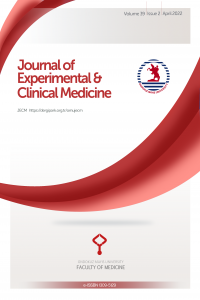Abstract
Kabuki Syndrome is disease derived from a rare genetic mutation that is particularly characterized by distinctive facial features, musculosketal malformations, mental retardation and cardiopulmonary anomalies and several pathologies. From anesthetic aspect, this syndrome may cause both cardiovascular and inspiratory problems, defects in palate and collum and also a number of difficulties in selecting medications and invasive procedures. Difficult intubation, prolonged neuromuscular blockage and malignant hyperthermia are frequently encountered problems in the patients with Kabuki Syndrome. An attentive examination of the patient in preoperative stage and appropriate medication preference is essential in order to prevent complications.
References
- 1. Cheon C-K, Ko JM. Kabukisyndrome: Clinical and molecular characteristics. Korean J Pediatr. 2015;58:317–24.
- 2. Matsumoto N, NiikawaN.Kabukimake-upsyndrome: a review. Am J MedGenet C Semin MedGenet. 2003 Feb 15; 117C(1):57-65.
- 3. Niikawa N, Matsuura N, Fukushima Y, Ohsawa T, Kajii T. Kabukimake-upsyndrome: a syndrome of mentalretardation, unusualfacies, largeandprotrudingears, andpostnatalgrowthdeficiency.J Pediatr. 1981 Oct; 99(4):565-9.
- 4. Niikawa N, Kuroki Y, Kajii T, Matsuura N, Ishikiriyama S, TonokiH,et al. Kabukimake-up (Niikawa-Kuroki) syndrome: A study of 62 patients. Am J MedGenet. 1988;31:565–89.
- 5. White SM, Thompson EM, Kidd A, Savarirayan R, Turner A, Amor D et al. Growth, behavior, andclinicalfindings in 27 patientswithKabuki (Niikawa-Kuroki) syndrome. Am J MedGenet A. 2004;127A:118–27.
- 6. Ng SB, Bigham AW, Buckingham KJ, Hannibal MC, McMillin MJ, Gildersleeve HI, et al. Exomesequencingidentifies MLL2 mutations as a cause of Kabukisyndrome.NatGenet. 2010 Sep; 42(9):790-3.
- 7. Adam MP, Hudgins L. Kabukisyndrome: a review. ClinGenet. 2005 Mar; 67(3):209-19
- 8. KabukiSyndromeGuideline Development Group. Management of KabukiSyndrome – A ClinicalGuideline (pdf). Availableonline. 2010. Erişim 10.09.2018
- 9. Johnson G, Mayhew JF. Anesthesiafor a childwithKabukiSyndrome. PaediatrAnaesth. 2007 Sep;17(9):900-1.
- 10. Atalay YO, Kaya C, Ustun YB, Sahinoglu AH. Anesthesia management in a patient with kabuki syndrome. MedArch. 2014 Oct;68(5):359-60.
Abstract
References
- 1. Cheon C-K, Ko JM. Kabukisyndrome: Clinical and molecular characteristics. Korean J Pediatr. 2015;58:317–24.
- 2. Matsumoto N, NiikawaN.Kabukimake-upsyndrome: a review. Am J MedGenet C Semin MedGenet. 2003 Feb 15; 117C(1):57-65.
- 3. Niikawa N, Matsuura N, Fukushima Y, Ohsawa T, Kajii T. Kabukimake-upsyndrome: a syndrome of mentalretardation, unusualfacies, largeandprotrudingears, andpostnatalgrowthdeficiency.J Pediatr. 1981 Oct; 99(4):565-9.
- 4. Niikawa N, Kuroki Y, Kajii T, Matsuura N, Ishikiriyama S, TonokiH,et al. Kabukimake-up (Niikawa-Kuroki) syndrome: A study of 62 patients. Am J MedGenet. 1988;31:565–89.
- 5. White SM, Thompson EM, Kidd A, Savarirayan R, Turner A, Amor D et al. Growth, behavior, andclinicalfindings in 27 patientswithKabuki (Niikawa-Kuroki) syndrome. Am J MedGenet A. 2004;127A:118–27.
- 6. Ng SB, Bigham AW, Buckingham KJ, Hannibal MC, McMillin MJ, Gildersleeve HI, et al. Exomesequencingidentifies MLL2 mutations as a cause of Kabukisyndrome.NatGenet. 2010 Sep; 42(9):790-3.
- 7. Adam MP, Hudgins L. Kabukisyndrome: a review. ClinGenet. 2005 Mar; 67(3):209-19
- 8. KabukiSyndromeGuideline Development Group. Management of KabukiSyndrome – A ClinicalGuideline (pdf). Availableonline. 2010. Erişim 10.09.2018
- 9. Johnson G, Mayhew JF. Anesthesiafor a childwithKabukiSyndrome. PaediatrAnaesth. 2007 Sep;17(9):900-1.
- 10. Atalay YO, Kaya C, Ustun YB, Sahinoglu AH. Anesthesia management in a patient with kabuki syndrome. MedArch. 2014 Oct;68(5):359-60.
Details
| Primary Language | English |
|---|---|
| Subjects | Health Care Administration |
| Journal Section | Case Report |
| Authors | |
| Early Pub Date | March 18, 2022 |
| Publication Date | March 18, 2022 |
| Submission Date | September 4, 2021 |
| Acceptance Date | February 17, 2022 |
| Published in Issue | Year 2022 Volume: 39 Issue: 2 |
Cite

This work is licensed under a Creative Commons Attribution-NonCommercial 4.0 International License.


